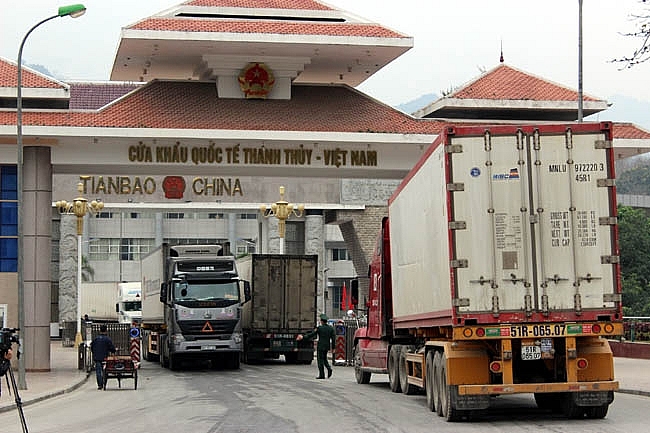Vietnam-China trade on path to recovery
 |
| The border gates to China have been reopened but added safety procedures make business slower than usual |
Trade activities at the border gates between Vietnam and China have been recovering. According to the northern border provinces' departments of industry and trade, between February 5 and March 19, 2020, 24,345 containers were exported, including 10,860 containers going through Lang Son province's border gates, 10,665 ones through Lao Cai province, 1,482 ones through Quang Ninh province, 956 ones through Ha Giang province, 310 ones through Lai Chau province, and 72 ones through Cao Bang province.
Additionally, 23,265 containers were imported, including 12,589 containers at Lang Son province's border gates, 6,770 ones at Lao Cai province, 3,882 ones at Quang Ninh province, and dozens of containers at Cao Bang and Lai Chau provinces' border gates.
However, this volume is still modest, with only 130-150 containers cleared at customs a day, half of which go into storage at the border gates on the Chinese side, and there are not enough workers for processing export-import activities, transportation, forwarding, and loading on either side.
At the same time, the clearance process is much slower than before due to implementing COVID-19 epidemic prevention measures. This is especially true as in March, the epidemic has been spreading faster in Vietnam than in the previous month.
The number of containers moving to the northern border areas is increasing, causing smaller congestions. As of last week, 1,141 containers were stuck at the northern border gates, especially in Lang Son province (1,068 containers carrying dragon fruit, watermelon, banana, mango, and jackfruit).
Thus, on March 20, the Ministry of Industry and Trade's Agency of Foreign Trade sent a document to the departments of industry and trade, business associations related to services, logistics, and export-import to encourage trade activities through the northern border provinces.
The document also raised recommendations like boosting exports to the Chinese market, along with complying with regulations on traceability, determining planting areas and packing facilities, in order to seize opportunities from China's recovery from the epidemic.
Moreover, authorities also encourage logistics businesses, particularly those who have frozen storage to support agriculture-fishery-fruit businesses in preserving their products during exportation in order to reduce costs of storage, logistics, and loading-unloading.
What the stars mean:
★ Poor ★ ★ Promising ★★★ Good ★★★★ Very good ★★★★★ Exceptional
Related Contents
Latest News
More News
- Vietnam’s green transition demands collective financial action (December 15, 2025 | 12:00)
- VIR workshop highlights capital and policy for sustainable development (December 15, 2025 | 11:00)
- National Assembly approves pilot mechanisms to accelerate major projects in Hanoi (December 12, 2025 | 11:29)
- Vietnam eases policy approval requirements, simplifies foreign and outbound investments (December 11, 2025 | 17:53)
- Unpacking new momentum in Vietnam’s M&A market (December 10, 2025 | 09:59)
- Forum honours outstanding M&A deals, strategies, and advisory firms (December 09, 2025 | 18:22)
- Vietnam enters defining phase of M&A growth (December 09, 2025 | 17:00)
- Vietnam’s M&A market opens new opportunities amid strong economic momentum (December 09, 2025 | 15:00)
- Vietnam M&A Forum 2025: new position, new momentum (December 09, 2025 | 14:30)
- FDI in Vietnam jumps on additional capital and share purchases (December 09, 2025 | 13:56)

 Tag:
Tag:



























 Mobile Version
Mobile Version